Newsletter April 2022
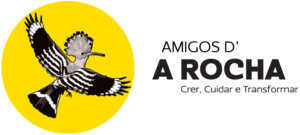
 Enjoy the beautiful spring 🙂 Happy Easter!
Enjoy the beautiful spring 🙂 Happy Easter!
This month learn about the Great Bustard and the effects of Climate change in the Mediterranean
Helen & Filipa
S
N
A
P
SHOT

Rachel Louise Carson

American Marine Biologist, Author and Conservationist
Born: 27th May, 1907, USA
Died: 14th April, 1964, USA
Rachel Carson, was born on the 27th of May, 1907, on a family farm in Pennsylvania, USA. From a young age she started to write stories, usually about animals; her favourite subjects were the natural word, particularly the ocean. She published her first book at the age of 10. In 1932, she finished her Master’s Degree in Zoology at the John Hopkins University and in 1934 she abandoned studies to work at the US Bureau of Fisheries, in a temporary position writing educational broadcasts to generate public interest in fish biology in which she was very successful.
In 1936, she became the 2nd woman employed by the US Bureau of Fisheries for a full time position as a junior aquatic biologist. In 1941 she published her first big book, “Under the Sea-wind” (describing how life was under the sea for 3 different creatures), the bestseller “The Sea Around Us”, in 1951, a biography of the sea, making Rachel a famous author and a full time writer. “The Edge of the Sea”, was published in 1955, about coastal ecosystems. Although her most important book was “Silent Spring”, published in 1962, raising awareness about the consequences of the use of synthetic pesticides like the DDT and how they accumulate on food chains.
Rachel Carson became a social revolutionary about environment issues; her ecological vision, knowledge and research about oceans sustainability lead to an environmental movement, to a national pesticide policy and the ban of DDT and other pesticides.
IFO’s – Identified Flying Objects…
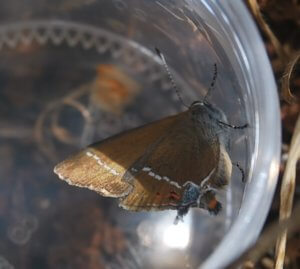
Blue Spot Hairstreak
(Satyrium spini, Schiffermüller, 1775)
Photo by Filipa Bragança

Morphology: It is a small butterfly from the Lycaenidae Family, with a wingspan between 28 to 33 mm. The upper side of the wings are plain brown; the underside of the wings are brown, both wings (fore and hindwing) are crossed by a transverse white line. The underside of the hindwing has a large blue spot below orange lunulae in anal angle. Females are slightly larger than males. One generation per year; the adults fly from April to August (depending on the location).
Habitat: Hot, dry and scrubby habitats, woodland clearings, grasslands, bushy meadows and bushy and rocky slopes.
Distribution: Southern and Central Europe (Portugal, Spain, France, Italy, Switzerland, Austria, Germany, Poland, Hungary, Croatia, Greece and Turkey) and east to Iraq and Iran.
Notes: The larvae feeds on Buckthorns (Rhamnus sp), and other species like Prunus, Frangula alnus, Crataegus monogyna, Sorbus and Malus. Adults feed on nectar of several herbaceous plants. The major threats are habitat loss.
Tweet… Tweet…


Photo cortesy of Aves de Portugal
Great Bustard
(Otis tarda, Linnaeus, 1758)
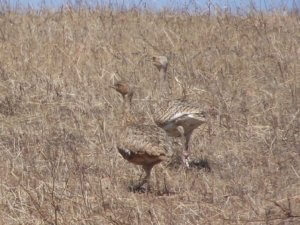
Photo by Filipa Bragança
Identification: It is a large bird from the Otidae Family, with a wingspan between 210 and 240 cm (males), 170 and 190 cm (females) and 90 to 105 cm (males), 75 to 85 cm (females) in length. The males are much larger than females; the plumage is brown barred with black above and white underneath; the breast and lower side of the neck is rufous and the head and upper neck blue-grey, males have thick necks. The wings are white with black around the edges, broad and fingered (more white in males). In the breeding season males have long white neck bristles.
Habitat and Ecology: Inhabits steppes, large and plain areas of grasslands and agriculture lands (cornfields) and fallow lands. The males show a spectacular display during breeding season, turning most part of the plumage inside out (showing and shaking white feathers). Females nest in the ground. The diet is varied and consists of plant matter (seeds, young plants, fruits, and grains) and small invertebrates.
Distribution: Europe, East Asia and North Africa (fragmented distribution, has disappeared from some countries); it is a resident bird, but some northern populations are migratory. In Portugal, this species is breeding in Alentejo (Castro Verde area).
Threats and Notes: Vulnerable (VU) according to the Red List of the International Union for Conservation of Nature (IUCN). The species has undergone a rapid population decline, due to habitat loss, agriculture intensification, hunting and collision with power lines. The Iberia Peninsula has around 60% of the world population.
DID YOU KNOW? 
-
Between 21st and 26th of March, A Rocha organized a “Pollinators week”, with several activities for schools and community. During this week it was possible to learn about the importance of pollinators and to discover some amazing species!

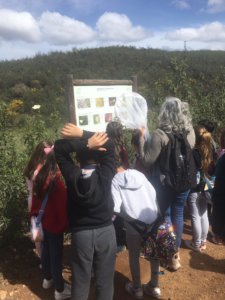
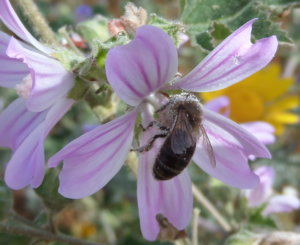
-
“Plastic – Free February”, joined several “A Rochas” around the world to reduce the amount of plastic. Read more here (from A Rocha International)
- Volunteers are back staying at the centre, Cruzinha; March was a busy month! A Rocha received 4 volunteers, and they are working on different projects:

Dasha (right) Roos (left)
Dasha Stalk, 26 years old, Slovenian, Volunteer ESC (European Solidarity Corps) for 1 year, working on the projects: “Micro-plastics? Big problem” (monitoring the plastics of some local beaches) and “Otters population” (evaluate the otter’s population in Ria de Alvor). Roos Reinartz, 25 years old, Dutch, Master Student of Forest and Nature Conservation at Wageningen University, staying for 2 months, working with Little owls (monitoring the population of Little Owls at Quinta da Rocha, by recording their sounds and location).

Maarten (right) Thijs (left)
Maarten Laban, 25 years old, Dutch, staying for 8 weeks, student of Professional School (AERES), in Ede, Netherlands, working on a project related to the Environmental Care Systems done in A Rocha Portugal. Thijs Ruijterlinde, Dutch, 18 years old, student of Professional School (AERES) in Ede, Netherlands, working on a project about reducing water consumption for watering plants.
- Spring is the time of flowers; fields are full of colours, some more amazing than others! Different shapes and sizes! Have you seen these beautiful orchids?

Mirror Orchid
(Ophrys speculum)

Sawfly Orchid
(Ophrys tenthredinifera)

Yellow Bee Orchid
(Ophrys lutea)

Bumblebee Orchid
(Ophrys bombyliflora)
Friends Event: “Exploring the Lagoa Rice Fields with Guillaume Réthoré”
13th April from 09:30 to 12:30 
Leaving Cruzinha by mini bus.
Gentle walk around the Quinta dos Vales Rice-fields, where we will hopefully see some interesting birds and enjoy Guis invaluable information on them and the area.
Please wear comfortable walking shoes, and provide your own water (we are no longer using plastic water bottles & recommend you have your own reusable non-plastic water bottle)
If you would like to be provided with a pair of binoculars, please let us know.
If the weather is wet the event will be cancelled and we will re-arrange for it to take place on another day.
Ticket price – 15 Euros (Friends) 20 Euros (Non Friends)
 INVASIVE SPECIES
INVASIVE SPECIES
Jimson Weed (Datura stramonium, L.)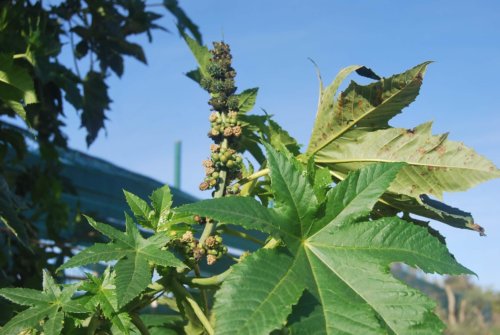
Clade: Angiosperms
Order: Solanales
Family: Solanaceae
Origin: Central America
Size: up to 2 metres in height
The Jimson Weed or Thorn Apple is an herbaceous annual plant; can grow up to 3 metres in height, forming a bush. The stem is rounded, erect, smooth, pale yellow-green or reddish purple and branched. The leaves are large, wide with irregular teeth at the margin; dark green above and light green underneath. The flowers grow at the axils of the leaves or where the branches fork, they are large creamy or violet with a trumpet shape. The fruits are ovoid capsules covered with spines, when mature it splits into 4 chambers releasing several black seeds. Flowers from June to October.
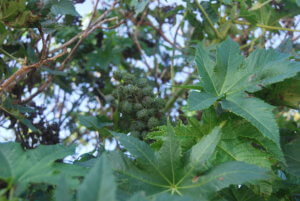 This species grows in cultivated lands, wastelands, roadsides, and garbage dumps. The origin of this species is unclear but most likely is native to Central America (or south of tropical America), nowadays is naturalized in all warm and temperate areas of the world (Europe, Asia, North America, North Africa and Australia) and in some regions it is considered invasive (E.g Portugal).
This species grows in cultivated lands, wastelands, roadsides, and garbage dumps. The origin of this species is unclear but most likely is native to Central America (or south of tropical America), nowadays is naturalized in all warm and temperate areas of the world (Europe, Asia, North America, North Africa and Australia) and in some regions it is considered invasive (E.g Portugal).
The Jimson Weed competes aggressively with other native plants and crops, forming monospecific stands; one single plant can produce thousands of seeds and seeds can remain viable on the soil for more than 40 years. All parts of the plant are toxic, specially the seeds, to humans and cattle.
POPPED UP
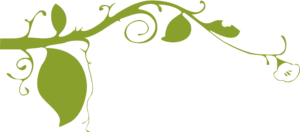
Family: Boraginaceae
Identification: It is biannual or perennial herbaceous plant, can grow between 20 and 90 in height. The stem is erect, hairy and can be branched at the top, the colour is green-whitish due to the soft hairs. The leaves are light green and oblong to lanceolate and also covered in small hairs. The flowers are bluish with fine purple or dark blue veins. Flowers from February to June.
Habitat and distribution: Meadows, pastures, farmlands, grasslands, and sometimes in roadsides and wastelands. It is native from the Mediterranean Region (southern Europe and Middle East).
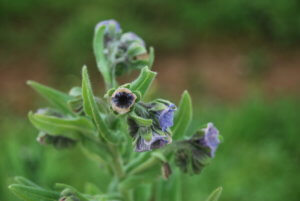
Photo by Filipa Bragança
Blue Hound’s-Tongue
(Cynoglossum creticum, Mill.)
Notes: The leaves are toxic for the cattle. The fruits of this species are covered with small hooks, it enables them to stick to animal fur and disperse the seeds. The Latin name of the species “Cynoglossum” derives from Greek and means dog’s tongue. This species was introduced in several countries where it is considered invasive, like the USA, Canada and Australia.
DATES TO REMEMBER

7th, 14th, 21st and 28th April – Cruzinha Birdringing display & Moth Talk (10am to 12 am). Book here
1st April – April Fool’s Day
13rd April – Friends Event
15th April – Good Friday (National holiday)
17th April – Easter Sunday (Holiday)
25th of April – Freedom Day, April’s Revolution, Carnation Revolution (National Holiday)
Thank you for supporting the Friends of A Rocha Portugal
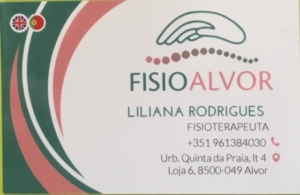
Physiotherapy, Massages (relaxation, sports, therapeutic)
Other therapies
Beauty (manicure, pedicure, hair removal, facials)
Open Monday to Friday

Dr Roy Rodrigues
Av. Do Brasil, Qta das Palmeiras, Lt P2, R/c A, 8500-299 Portimão
(+351) 282180683
royaldente@gmail.com
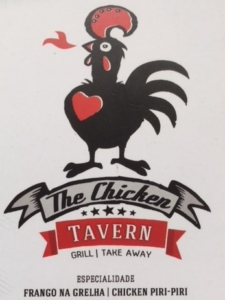
Urbanização Mar e Serra n° 47, Alvor
8500 – 783 Portimão
(+351) 911597735
Thought of the month 
“He that plants trees loves others besides himself.”
—Thomas Fuller (1608 – 1661) English Historian, Churchman and writer

LETS BE GREEN – LETS BE GREEN – LETS BE GREEN 
Drought is a big problem! Is never too often to remind people how we can reduce our water consumption.
- Collect the rain water (use bowls and store it in a sealed recipient, you can use it later for watering your plants)
- In the shower, don’t keep the tap always open (water yourself and turn the tap off while you lather)
- Brushing your teeth (use a glass to flush your mouth, you can save a lot of water like this)
- Make sure your taps don’t drip
- Washing dishes (don’t keep the tap always running, first foam it and then rinse off all together; turn on the washing machine just when it is totally full)
- Washing the car ( don’t use the hose but a bucket)
- Washing fruits and vegetables (use a bowl to wash them and after you can use the water for watering the plants)
- Clean the yard (don’t use water just sweep it)
- Air conditioner (reuse the water which drops from your air conditioner to water plants)
LETS BE GREEN – LETS BE GREEN – LETS BE GREEN
Ringing report 2021
Every year, A Rocha publishes the Ringing report, with the information about the numbers and species caught. In 2021 there were 631 birds caught of 46 different species. Most of the information is collected at our ringing station at Cruzinha, but last year, the A Rocha team also did some ringing in Estômbar. The number of birds over the years is decreasing, this is a global trend and further analysis should be done to confirm these results.
Some of the species caught in 2021, have not been caught for some time, like the Woodchat Shrike (Lanius senator), last caught in 2012, the Crested lark (Galerida cristata), in 2008, the Northern Wheatear (Oenanthe oenanthe), since 2004, the Crossbill (Loxia curvirostra), since 1997 and the Meadow Pipit (Anthus pratensis), since 2014.
The numbers of our resident birds are decreasing (House Sparrow, Goldfinch and Blue Tit), but the numbers of some migrants or winter birds increased (Garden warbler, Song Thrush and Siskin). See the full report here
Climate change- Portugal
The report of the Intergovernmental Panel on Climate Change (IPCC), in august 2021, reveals worrying projections for the Mediterranean Region. This region is highly vulnerable and has less chances to deal with climate change. The decrease of the average of annual rainfall is already happening and this has severe consequences to the regions, causing problems in agriculture, forests fires and availability of water.
Some Mediterranean regions will see a decrease of 64% in their crops, and the rural burned area will double. Only, if the global warming will be less than 2° C, will it be possible to maintain the coastal areas and the marine and terrestrial ecosystems healthy.
In the future, forest fires will be more frequent, as well as the heat waves; in Portugal the scenario won’t be different, with extreme weather conditions, like heat waves, droughts and sea level rise (causing floods and costal erosion), this will lead to desertification, decrease of crops, increase of diseases and air pollution.
Sustainability Champions 
Sustainability Champions from around the World– Looking at ways to curb pollution and waste management.
We would like to thank Daniel Hartz, the founder of Sustainability Champions for giving us the permission to share this information.
As part of a final project for their Master’s degree in mechanical engineering at the University of Sherbrooke, 12 students invented a beach vacuum cleaner that sucks up microplastics and returns the sand to the beach. At the end of their undergraduate program, Jean-Felix Tremblay, together with Jean-David Lantagne and Anne-Sophie Lapointe, decided to pursue the project and help clean beaches.
 The trio started Hoola One Technologies to tackle the huge problem of microplastics embedded in beach sand.The vacuum-like contraption sucks up sand and uses a tank of water to separate floating microplastics from sinking natural material, which is then returned to the beach. Meanwhile, the microplastics which can be as small as 0.05millimeters are siphoned off and contained.
The trio started Hoola One Technologies to tackle the huge problem of microplastics embedded in beach sand.The vacuum-like contraption sucks up sand and uses a tank of water to separate floating microplastics from sinking natural material, which is then returned to the beach. Meanwhile, the microplastics which can be as small as 0.05millimeters are siphoned off and contained.
This Hoola One has been tested on Kamilo Beach in Hawaii, one of the most polluted shores in the world. Trials show it could clean three gallons of sand a minute, and gobble up 48kilograms of microplastics in just a few hours.
The team left their invention as a donation to the island so locals can continue to use it on their beach cleans. The prototype model is very large and has to be transported on a trailer. Given the success of the project, they hope to raise money for smaller versions of the vacuum to make them available for use around the world.

Work with fishing communities among Natura 2000 Award finalists

Balearic Shearwater
Photo by Nuno Barros
Until 27 of April, the MedAves Pesca project – Fishermen and seabirds, allies for the sea – is up for votes in the European Natura 2000 Award. The project, in which conservationists from the Portuguese Society for the Study of Birds (SPEA) worked closely with fishermen from Peniche to mitigate one of the biggest threats to seabirds, is one of the 21 finalists in this award run by the European Commission. Alongside the vote for the “Citizens Prize”, the project will also be assessed by a jury, in the Marine Conservation category.

Check the website for dates for organised tours
Guillaume Réthoré (Gui)- My life with birds: Squacco Heron (Ardeola ralloides)
For this month, I chose a picture of one of the prettiest herons we have in Portugal: the Squacco Heron. I actually have not seen one for a few years 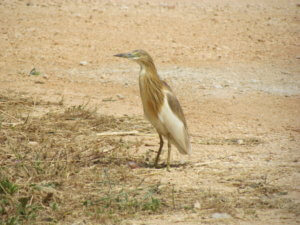 now and I have never seen one as well as this occasion.
now and I have never seen one as well as this occasion.
This picture also illustrates how great a photographic hide a car can be. On that day, I was finishing the wader count with a volunteer and on our way back, as we drove past the fish farm, this heron was standing on the side of the road. We had great views during several minutes and managed to take a few pictures without leaving the car and stressing the bird. It is a species which usually appears in spring in the Algarve.
Text and photo by Guillaume Réthoré
Editor: Filipa Bragança
English proof reading: Helen Rodda
Portuguese proof reading: Lena Soares
Production controller: Helen Rodda
Email: friends.arpt@arocha.org
Thank you for supporting us!
Hope to see you soon!


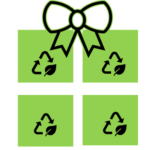 What makes a good Birthday present?
What makes a good Birthday present?

